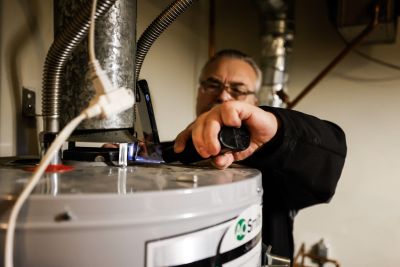Discovering a Career as an Energy Rater

For Alex Twogood of Skyfire Inspections, building and adapting housing for Alaska’s unique climates is a family legacy – one that has evolved over the years as new research and innovations make housing more efficient, affordable and comfortable.
Alex grew up in Fairbanks watching his dad build homes and install radiant heat and later joined his father’s business, helping to build residential and small commercial properties.
In the '90s, he saw an article in his local paper offering a chance to become an Alaska Housing Finance Corporation certified home inspector. Alex recalls that the class and certification process only cost $100 at the time and that all the requirements matched the experience he’d gained working for his family company.
“I didn’t know it at the time but the home inspection certification was also an energy rater certification,” Alex recalled.
Alex discovered he was an energy rater when a friend recognized his name on a list of certified professionals and called him to schedule an energy rating for his home.
When AHFC started administering energy rebates in 2006 Alex took more classes with AHFC to expand his knowledge on energy efficiency. “That’s when I became a real energy rater,” he said.
“Way back when I started, I didn’t know what the science was behind an energy efficient home. I have to credit Alaska Housing for helping me learn. I now feel confident assessing each house and understanding what it needs for its highest use. That comes from my experience but also from the training I’ve received.” – Alex Twogood, Skyfire Inspections, Fairbanks
The Energy Efficiency Equation
As Alex explains it, an energy rating focuses on the interactions between three key elements:
- How the house is insulated – From window and door types to the thickness, type and location of insulation, this component is concerned with everything that keeps heat in a home and how well it accomplishes this task.
- How the house produces heat – This includes the heating system type, fuel type and how the system heats hot water.
- How airtight the house is – The tighter the house, the more energy efficient it is. After a certain amount of tightness, air quality suffers and carbon monoxide poses a risk. Ventilation is introduced to avoid humidity and air quality issues.
Alex has fine-tuned his approach to solving this equation through years of training and hands-on experience. “In Ketchikan you have to build for rain, in Fairbanks you have to build for cold, in Kotzebue you have to build for cold wind,” he explained. “But it’s all the same mathematical equation. You need to know how to focus on the correct part of the equation for the area you’re in.”
Collaborating for the Benefit of the Community
Learning how to confidently solve that equation in varying climates has involved extensive training, staying on top of industry updates and innovations and collaboration with other professionals.
“When I come across a situation I don't understand, I turn to AHFC,” Alex said, giving his first interaction with a heat pump as one example.
“About 10 years ago I had to do a rating on a house with a heat pump rather than a boiler. Heat pumps were unique in Fairbanks at that time and I was scratching my head. I made an appointment with AHFC staff to talk about the situation and they did deep research and accessed information I wouldn’t have found, finding a solution for me. I’ve always felt that they had my back.”
From helping Alex with initial research on heat pumps to providing ongoing training and recertifications, AHFC has partnered with energy raters across Alaska to share knowledge and ensure communities across the state have access to trained, experienced professionals.
In February 2025, Alex attended Energy Efficiency NOW Training in Anchorage hosted by AHFC. In addition to getting to test out new equipment that he doesn’t encounter in Fairbanks very often, Alex said he benefited from the time with his colleagues from across the state, many of whom have 20-30 years of experience in the industry.
“I think of it like navigating from a boat using several reference points on the shoreline,” Alex said. “Different people with experience on the same thing give you bearings from different angles. Where those ideas come together gives us a solid foundation of reality. We make each other better energy raters.”
“Through all the classes and certifications over the years, I’ve come to respect Alaska Housing. Their mission statement is about safe and affordable housing and they are always trying to learn more and pass that information on to us energy raters. They want us out there doing a good job.” – Alex Twogood, Skyfire Inspections, Fairbanks
Need a home energy rating? View a list of certified professionals across Alaska.
To learn more about energy efficiency and find AHFC resources for homeowners, property owners and building professionals, visit ahfc.us/efficiency.
![Alaska Housing Finance Corporation [Logo]](/application/themes/ahf2/images/logo.png?v=2)